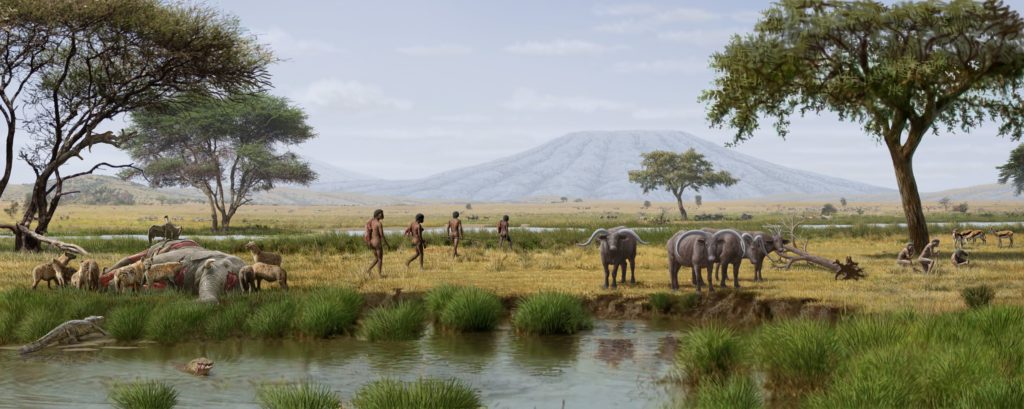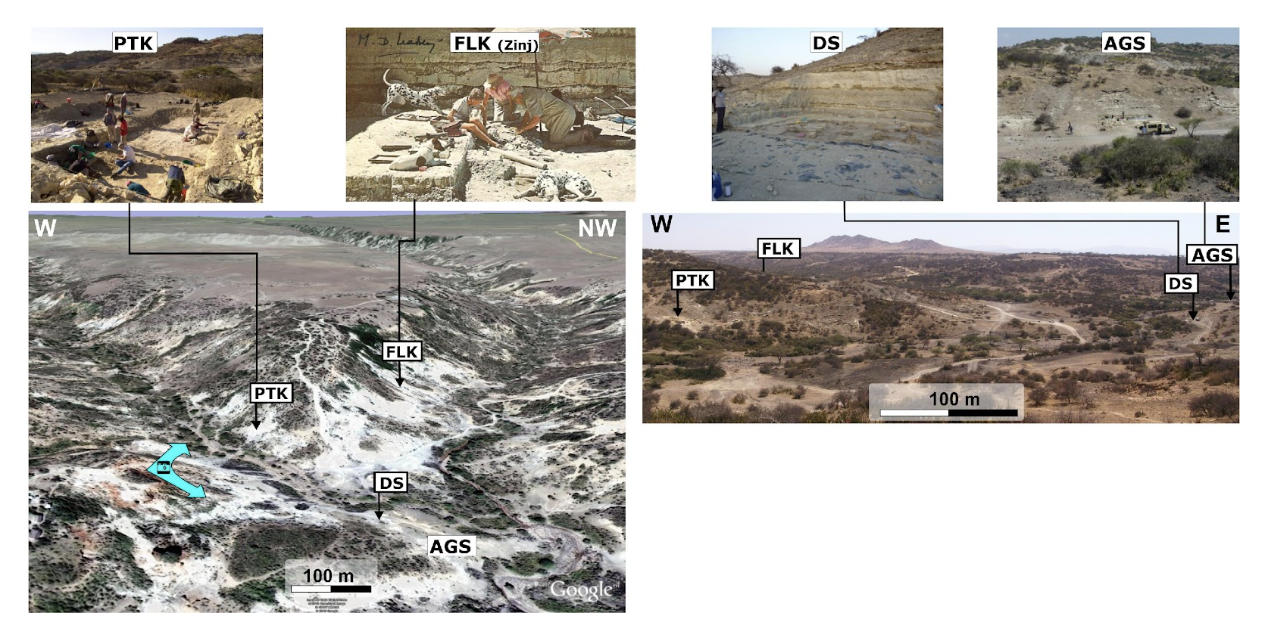
©Mauricio Antón
Project summary
Two exceptionally-preserved paleolandscapes from Olduvai Gorge (Tanzania), spanning the oldest Oldowan (1.85 Ma) and the emergence of the Acheulian (1.7 Ma), containing fully anthropogenic sites (as opposed to just palimpsests), will be studied through a new high-resolution meso-scale paleoecological reconstruction. A new technique based on artificial intelligence deep learning applied to reconstructed paleolandscapes has enabled the discovery, after more than 50 years, of new sites at Olduvai Beds I and II. These sites occur in specific locations on the paleolandscape and this has profound behavioral and paleoecological meaning.
The goals of this proposal are the reconstruction of site functionality and the socio-economic evolution of human behavior during these two crucial periods. For this purpose, a combination of biomarker-phytolith-starch analyses on stone tools and sediments (in-site and off-site), never attempted before in the African early Pleistocene, will be used jointly with technological and taphonomic analyses to understand the range of activities hominins performed at Oldowan and Acheulian sites and how these shaped their socio-ecology. Also, detailed reconstruction of the paleovegetation and physical resources of the environment in the habitats were sites were located will enable to determine why hominins selected specific loci of the landscape.
Assessing the degree of integrity of these sites is crucial to understand the behavioral meaning of the spatial associations of tools and bones. For this reason, sophisticated modelling of hydraulic processes on the reconstructed paleolandscapes and, specifically, on sites will be performed. This project will carry out and study the most extensive excavations of anthropogenic sites in the African Pleistocene. At the heart of what hominins did in the selected Oldowan and Acheulian sites lies the question of how human cooperation and socio-economic behavior emerged and how it evolved during the most crucial period of human evolution: the transition from early Homo to Homo erectus/ergaster. The projects is a ground-breaking approach to understanding the origin of human behaviour.
Extended Synopsis of the project
One of the main objectives of paleoanthropology is the identification of the socio-reproductive organization and subsistence strategies that created human behavior. During the 1970s and 1980s several models emerged to interpret socio-economic behaviors of early hominins through the analysis of the Early Pleistocene archaeological record in Africa. Some models emphasized socio-economic behaviors that resembled those of some modern foraging populations (e.g., Leakey´s “living-floors”; Isaac´s “home base” or “food-sharing” models). Subsequent revisionist models (with a concern for site formation processes) during the 1980s produced ethological models in which hominins had social behaviors that were more similar to those of other non-human primates, such as the marginal or obligate scavengeror the passive scavenger models, the stone-cache model, the “chimpanzee-nesting” model, or the “refuge” model,.
The information gap between the reconstruction of site formation (through taphonomic analysis of materials preserved at sites) and the hominin socio-economic organization required to sustain any of the above models led scholars to abandon social and functional interpretations based on modeling of early sites. Today, thirty years after some of the most important behavioral models were proposed, it is fair to state that we know very little about early Pleistocene site functionality and about hominin socio-economic behavior.
Read more
The project aims at a breakthrough in the knowledge of the socIo-economic organization in early humans that led to the emergence of the Oldowan archaeological record and its evolution into the Acheulian. This will create a crucial bridge between archaeology and physical anthropology by understanding the evolution of early Homo. To achieve this goal we propose a new method based on combining artificial intelligence tools, modelling of hydraulic inputs, the latest biomolecular and paleobotanical techniques to a new scale of understanding early human archaeology: the meso-scale, which targets detailed reconstruction of the paleogeography and paleoecology of the habitats where sites were formed at a distance of just a few km. To reach this goal, it will be fundamental also to recreate the complex environment and natural selection factors that existed in the landscapes that those hominins were adapted to by carrying out comprehensive research of modern savanna ecosystems.
Our team has uncovered since 2012 four 1.84 Ma new anthropogenic sites at Olduvai Gorge (Tanzania). Two of these are spatially bigger and denser in fossils and stone tools than the most widely studied Early Pleistocene site (FLK Zinj) in Africa. The co-occurrence of all these sites on the same paleosurface enables for the first time the research into these topics:
- High-resolution study of site functionality and behaviour variability across space. This includes seasonality in the occupation, reconstruction of diet, strategies of meat acquisition and consumption, use of plant resources and diversity of tool kits used for early human activities.
- High-resolution reconstruction of the paleolandscape vegetation, topography and biocoenoses at a meso scale (several km2), since paleolandscapes (including paleosols) can be traced extensively in modern outcrops.
- Extract for the first time, molecular information from sediments of the sites and from their tools to reconstruct “invisible” activities, including the exploitation of plant resources. Recent application of biomarker analysis at some of the sites is uncovering the presence of colesterol in locations were butchery was carried out. Also, microscopic residues and their associated biomarkers are being recovered from stone tools. This has never been done before in this time period, opening a new way of doing prehistoric archaeology and understanding human evolution.
Read more
Objectives
Background and state-of-the-art
Over the past half-century, most of the behavioral models described earlier have been “tested” or applied primarily to sites discovered in Bed I at Olduvai Gorge, the best-preserved archaeological record for the East African Early Pleistocene. The reasons are:
- Only in Olduvai are there extensively excavated sites with good preservation of materials, which have enabled taphonomists to understand hominin interaction with other site formation agents.
- At Olduvai, these anthropogenic sites and their landscapes can be extensively traced horizontally on paleosols and paleosurfaces.
- Olduvai Gorge is situated within the active ecosystem of Serengeti, providing an observable example of trophic dynamics within biocoenoses similar to those of the Early Pleistocene basin.
The paleosol underlying Tuff IC in Bed I contains a thin clay stratum (<20 cm) which can be traced laterally on a good portion of the gorge at the junction and beyond. The stratum can also be traced on both sides of the side gorge for over one-third of its northernmost trajectory. This provides an extensive paleolandscape. This stratum contains the oldest taphonomically-secure anthropogenic sites. (Fig. 1) This will be the first time that multiple sites from the same paleosurface will be simultaneously analyzed within their respective ecological contexts and with consideration of the trophic dynamics of their surrounding landscapes (see for recent advances on this approach).
An extensive anthropogenic archaeological record identified in lowermost Bed II (ca. 1,7 Ma), provides an exceptional opportunity to understand hominin behavior during the emergence of the Acheulian. At this time there is a higher diversity of sites, and probably behavior, as reflected in sites with Acheulian implements without clear association with faunal exploitation and sites with Oldowan tools used for butchery purposes (Fig. 2). This period also shows more frequent exploitation of megafauna, which must have been of adaptive importance for hominins. The deposit spanning lowermost Bed II is widespread both in the main and the side gorges.

A site’s functionality is tightly linked to the ecology of its surroundings: hominins selected specific spots on the landscape for certain activities because particular ecological characteristics enabled these activities. A better understanding of paleoecological conditions is crucial to uncovering site functionality and hominin behavior. Understand how this relates to trophic dynamics requires the reconstruction of ecological systems (ecosystems in the true sense of the word), turning static paleoenviromental information into dynamic functional ecological systems. The latest biomolecular techniques that are being applied in samples from Mars to look for evidence of life will be applied for the first time to an archaeological context to look for traces or organic materials at sites. The results of the biomolecular analysis of sites, paleolandscapes and stone tools are intended to provide, in conjunction with the analysis of phytoliths and starches, paleobotanical evidence for the vegetation at sites and their surrounding environments as well as evidence of plant exploitation by hominins. Knowing where sites occur in the catena of paleohabitats will contribute to understand why the locations of sites were selected by hominins and what activities were performed in them. Recent work at the FLK West Acheulian paleolandscape is showing a repeated association of hominin activities by hot springs. This is behaviorally and adaptatively important.

Figure 2. 3D geomorphological reconstruction of the LAS unit between Long Korongo and FLK Fault, during dry season (Olduvai Bed II). This paleolandscape records the oldest Acheulian at Olduvai and contains a wealth of Acheulian and Oldowan sites on the same paleosurface: FLK West, HWKE, HWKEE, HWKM, RH1, RH2. Some of these sites have recently been found with the aid of artificial intelligence algorithms.
The spatial distribution of stones and bones contains crucial information about social behaviors of hominins provided they were not altered by postdepositional processes. Large excavations could unveil how hominins used the “domestic” space collectively and the identification of activity areas. To assess site integrity, it is important to understand how these properties were preserved by biotic and abiotic sedimentary processes. Large-scale modelling of hydraulic processes at different ranges of interplay between lake cycles and fluvial inputs will show the areas of the landscape more prone to be impacted by water and their relation to site location. Once the paleolandscape is reconstructed and the array of sites is displayed, artificial intelligence spatial algorithms specifically developed by our project project the most likely areas of occupation by hominins. This is how in just six years we have doubled the number of sites known for Bed I during the whole XXth century.
Read more
This is a ground-breaking approach to understanding the origin of human behavior. It can provide information crucial to overcoming the stasis in the past three decades of modeling early human adaptive patterns. The ultimate goal is to provide new tools to understand how human behavior emerged during the Oldowan and evolved into behaviors associated with the Acheulian. This has never been done before and it will open a new way of doing prehistoric archaeology and understanding human evolution. It will be the first time that a static system from the past is brought to life in such a complex and dynamic way. It will also be the first time that this is done to understand how early humans and their behaviour appeared and varied across the landscape.